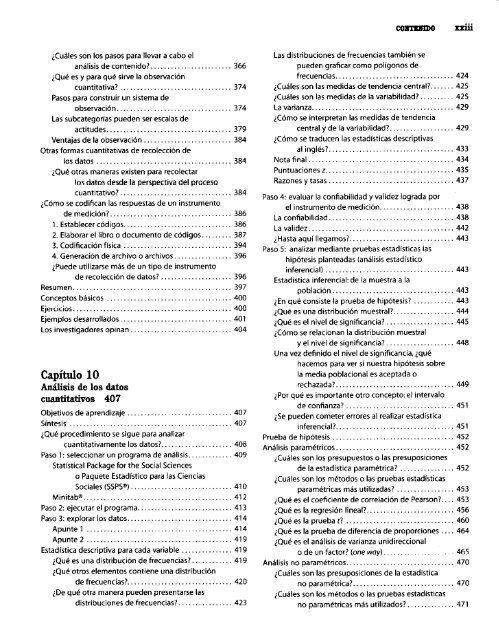metodologia-de-la-investigacion_4ta-edicion_sampieri-20061
metodologia-de-la-investigacion_4ta-edicion_sampieri-20061
metodologia-de-la-investigacion_4ta-edicion_sampieri-20061
Create successful ePaper yourself
Turn your PDF publications into a flip-book with our unique Google optimized e-Paper software.
&~áles son los pasos para llevara cabo el<br />
análisis <strong>de</strong> contenido?. ....................... 366<br />
iQué es y para qué sirve <strong>la</strong> observación<br />
cuantitativa? ................................. 374<br />
Pasos para construir un sistema <strong>de</strong><br />
observación.. ................................ 374<br />
Las subcategorias pue<strong>de</strong>n ser esca<strong>la</strong>s <strong>de</strong><br />
actitu<strong>de</strong>s ..................................... 379<br />
Ventajas <strong>de</strong> <strong>la</strong> observaci6n .......................... 384<br />
Otras formas cuantitativas <strong>de</strong> recolecci6n <strong>de</strong><br />
los datos ........................................ 384<br />
¿QUé otras maneras existen para recolectar<br />
los datos <strong>de</strong>s<strong>de</strong> <strong>la</strong> perspectiva <strong>de</strong>l proceso<br />
cuantitativo?. ................................ 384<br />
@,,o re codifican <strong>la</strong>s respuestas <strong>de</strong> un instrumento<br />
<strong>de</strong> medición?. ................................... 386<br />
1. Establecer códigos ................................ 386<br />
2. E<strong>la</strong>borar el libro o documento <strong>de</strong> códigos ......... 387<br />
3. Codificación física ................................ 394<br />
4. Generación <strong>de</strong> archivo o archivos ................. 396<br />
iPue<strong>de</strong> utilizarse mds <strong>de</strong> un tipo <strong>de</strong> instrumento<br />
<strong>de</strong> recolección <strong>de</strong> datos? ..................... 396<br />
Resume”. .............................................. 397<br />
Conceptos básicos ..................................... 400<br />
Ejercicios ............................................... 400<br />
Ejemplos <strong>de</strong>sarrol<strong>la</strong>dos ................................. 401<br />
Los investigadores opinan .............................. 404<br />
Capítulo 10<br />
Análisis <strong>de</strong> los datos<br />
coantitativos 407<br />
Objetivos <strong>de</strong> aprendizaje ............................... 407<br />
síntesis ................................................ 407<br />
¿Qué procedimiento se sigue para analizar<br />
cuantitativamente los datos?. .................... 408<br />
Paro 1: seleccionar un programa <strong>de</strong> andlisis ............. 409<br />
Statlstical Package for the Social Sciences<br />
o Paquete Estadístico para <strong>la</strong>s Ciencias<br />
Sociales WPS”) .............................. 410<br />
Minitab”. ........................................... 412<br />
Paso 2: ejecutar el programa ............................ 413<br />
Paso 3: explorar los datos ............................... 414<br />
Apunte 1 ........................................... 414<br />
Apunte 2 ........................................... 419<br />
Estadirtica <strong>de</strong>scriptiva para cada variable ............... 419<br />
iQué es una distribución <strong>de</strong> frecuencias?. ........... 419<br />
)Que otros elementos contiene una distribuci6n<br />
<strong>de</strong> frecuencias?. .............................. 420<br />
$e qué otra manera pue<strong>de</strong>n presentarse <strong>la</strong>s<br />
distribuciones <strong>de</strong> frecuencias?. ............... 423<br />
WlITmmmxxlu<br />
Las distribuciones <strong>de</strong> frecuencias también se<br />
pue<strong>de</strong>n graficar como pollgonos <strong>de</strong><br />
frecuencias ................................... 424<br />
&udles son <strong>la</strong>s medidas <strong>de</strong> ten<strong>de</strong>ncia central?. ...... 425<br />
iCuáles son <strong>la</strong>s medidas <strong>de</strong> <strong>la</strong> variabilidad?. ......... 425<br />
La varianza .......................................... 429<br />
Qmo se interpretan <strong>la</strong>s medidas <strong>de</strong> ten<strong>de</strong>ncia<br />
central y <strong>de</strong> <strong>la</strong> variabilidad?. .................. 429<br />
@,,o se traducen <strong>la</strong>s estadirticas <strong>de</strong>scriptivas<br />
al inglés? ..................................... 433<br />
Nota final ........................................... 434<br />
P”nt”acionerz.. .................................... 435<br />
Razo”esytasas.....................................43 7<br />
Paso 4: evaluar <strong>la</strong> confiabilidad y vali<strong>de</strong>z lograda por<br />
el instrumento <strong>de</strong> medición ...................... 438<br />
La confiabilidad ..................................... 438<br />
La vali<strong>de</strong>z ........................................... 442<br />
&<strong>la</strong>rta aquí llegamos?. .............................. 443<br />
Paso 5: analizar mediante pruebas estadísticas <strong>la</strong>s<br />
hipótesis p<strong>la</strong>nteadas (análisis estadístico<br />
inferencia,, ...................................... 443<br />
Estadistica inferencial: <strong>de</strong> <strong>la</strong> muestra a <strong>la</strong><br />
pob<strong>la</strong>ción.. .................................. 443<br />
iEn qué consiste <strong>la</strong> prueba <strong>de</strong> hipótesis? ............ 443<br />
iQué es una distribuciOn muestral?. ................. 444<br />
>Qué es el nivel <strong>de</strong> significancia? .................... 445<br />
@,,o se re<strong>la</strong>cionan <strong>la</strong> distribución muestral<br />
y el nivel <strong>de</strong> significancia? .................... 448<br />
Una vez <strong>de</strong>finido el nivel <strong>de</strong> significancia. iqué<br />
hacemos para ver si nuestra hipótesis sobre<br />
<strong>la</strong> media pob<strong>la</strong>cional es aceptada o<br />
rechazada? ................................... 449<br />
ipor qué es importante otro concepto: el intervalo<br />
<strong>de</strong> confianza? ................................ 451<br />
iSe pue<strong>de</strong>n cometer errores al realizar estadística<br />
inferencial?. .................................. 451<br />
Prueba <strong>de</strong> hipótesis .................................... 452<br />
Análisis param&ricos ................................... 452<br />
&uáles SO” los presupuestos 0 <strong>la</strong>s presuposiciones<br />
<strong>de</strong> <strong>la</strong> estadistica paramétrica? ................ 452<br />
iCuáles son los m&odos o <strong>la</strong>s pruebas estadísticas<br />
paramétricas más utilizadas! ................. 453<br />
iQué es el coeficiente <strong>de</strong> corre<strong>la</strong>ción <strong>de</strong> Pearson?. ... 453<br />
iQué es <strong>la</strong> regresión lineal?. ......................... 456<br />
iQué es <strong>la</strong> prueba t? ................................ 460<br />
iQué es <strong>la</strong> prueba <strong>de</strong> diferencia <strong>de</strong> proporciones .... 464<br />
iQué es el análisis <strong>de</strong> varianza unidireccional<br />
o <strong>de</strong> un factor? (ene way). .................... 465<br />
Análisis no paramétricos ................................ 470<br />
iCuáles son <strong>la</strong>s presuposiciones <strong>de</strong> <strong>la</strong> estadística<br />
no paramétrica?. ............................. 470<br />
&udles son los m&odos o <strong>la</strong>s pruebas estadisticas<br />
no paramétricas más utilizados?. ............. 471<br />
. . .


